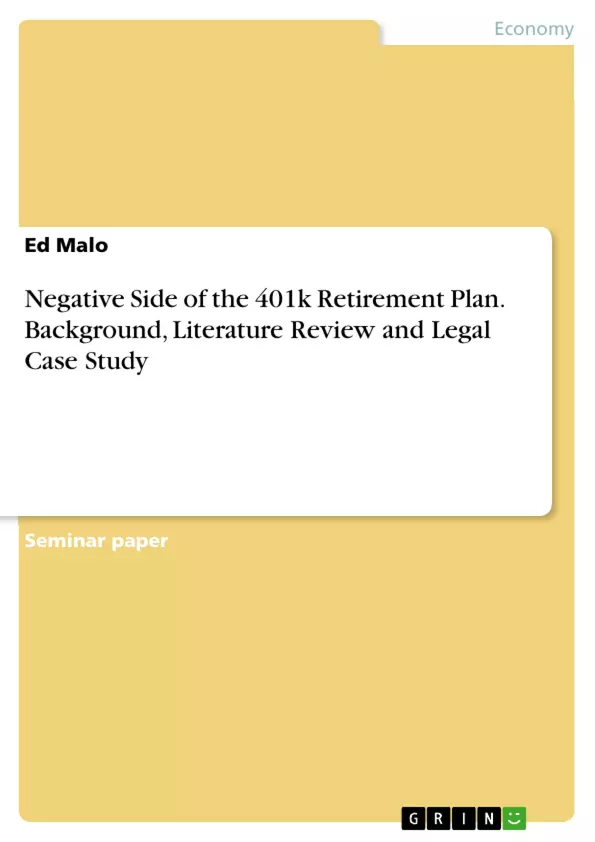The purpose of this paper is to review the often overlooked negative side of the 401(k) retirement plan. Several major drawbacks of the 401(k) such as insufficient investing, poor asset allocation and the detrimental effect of market volatility ever more apparent by current economic conditions are discussed. The still developing legal liability of 401(k) plans and those implications for Human Resource professionals is also presented through a legal case study.
More and more Americans rely more heavily on 401(k) retirement plans with the worsening Social Security situation, the decline of pension plans and the commonly held belief that 401(k)s are the superior choice for an adequate retirement. However this belief is rarely questioned, and even less so in prosperous economic times when the inherent high risk associated with many types of investments in 401(k) plans produce good results. Some financial advisors, economists and even lawmakers though have begun to scrutinize the nearly always positive image of 401(k)s for investing in retirement. It goes without much contention though that part of this new scrutiny is of course motivated by current worsening economic conditions.
Experts point to a myriad of misconceptions and inherent shortcomings in the current 401(k) system. These include unguided and often insufficient investing, hidden and sometimes substantially detrimental plan fees, poor asset allocations on investments, inherent and damaging stock market volatility and more. While most financial planners continue to hold that the 401(k) is an excellent way to invest in one’s retirement, some questions are being raised and there is perhaps a growing need for more explanation with that recommendation now.
First background information about the 401(k) retirement plan is presented including its basis in laws related to Human Resources and a brief demonstration of its rise in popularity. Next, the negative side of the 401(k) is presented through a literature review organized by several major bullet points. Lastly, a legal case study is presented to reinforce human resource related employer legal liability followed by the paper’s conclusion.
Inhaltsverzeichnis (Table of Contents)
- Introduction
- Abstract
- Background Information
- Basis in Law
- Growing Popularity
- Literature Review
- Replacing the Pension
- Insufficient Investing
- Hidden Fees and High Costs
- Asset Allocation
- Market Volatility
- Legal Case Study
- Conclusion
- References
Zielsetzung und Themenschwerpunkte (Objectives and Key Themes)
This paper examines the often overlooked negative aspects of the 401(k) retirement plan. It explores the disadvantages of the 401(k) system, including insufficient investing, poor asset allocation, and the detrimental impact of market volatility, particularly in light of current economic conditions. The paper also investigates the evolving legal liability of 401(k) plans and their implications for Human Resource professionals through a legal case study.
- The shortcomings of 401(k) plans and their potential for inadequate retirement savings.
- The impact of market volatility on 401(k) investments and its implications for retirement security.
- The legal liability of employers associated with 401(k) plans and the responsibilities of Human Resource professionals.
- The importance of informed decision-making and proper asset allocation in 401(k) investments.
- The need for a critical evaluation of the 401(k) system and its effectiveness in achieving retirement goals.
Zusammenfassung der Kapitel (Chapter Summaries)
The introduction provides an overview of the growing reliance on 401(k) retirement plans, highlighting the concerns about their potential drawbacks, particularly in the face of economic challenges.
The background information section delves into the legal framework surrounding 401(k) plans, including the Employee Retirement Income Security Act (ERISA) and its provisions regarding contributions, vesting, and other aspects of retirement plans. The section also explores the rise in popularity of 401(k) plans, illustrating their increasing prevalence in the United States.
The literature review section examines several key criticisms of 401(k) plans, including insufficient investing practices, hidden fees, poor asset allocation strategies, and the vulnerability to market volatility.
The legal case study provides a real-world example of the legal liability associated with 401(k) plans, highlighting the potential consequences for employers and Human Resource professionals.
Schlüsselwörter (Keywords)
This paper focuses on the 401(k) retirement plan, exploring its potential drawbacks, including insufficient investing, market volatility, asset allocation, and legal liability. It examines the role of ERISA and its implications for employers and employees. Key themes include retirement planning, investment strategies, financial risk, and legal compliance.
- Citation du texte
- Ed Malo (Auteur), 2008, Negative Side of the 401k Retirement Plan. Background, Literature Review and Legal Case Study, Munich, GRIN Verlag, https://www.grin.com/document/303372



